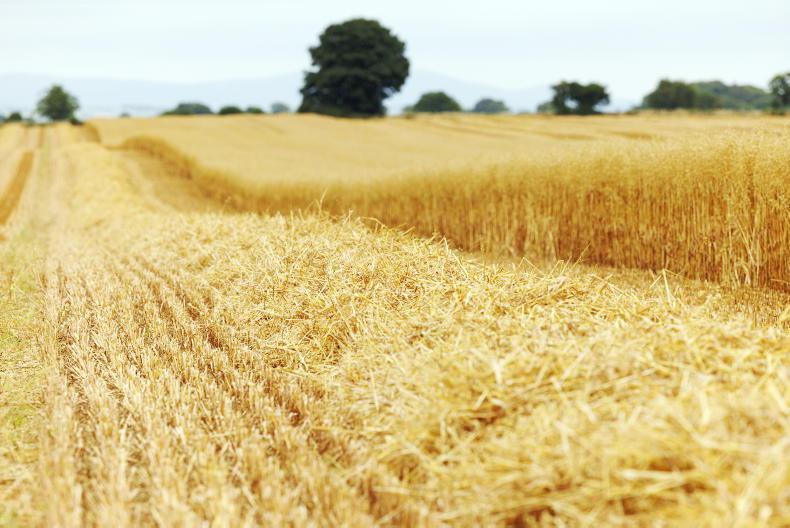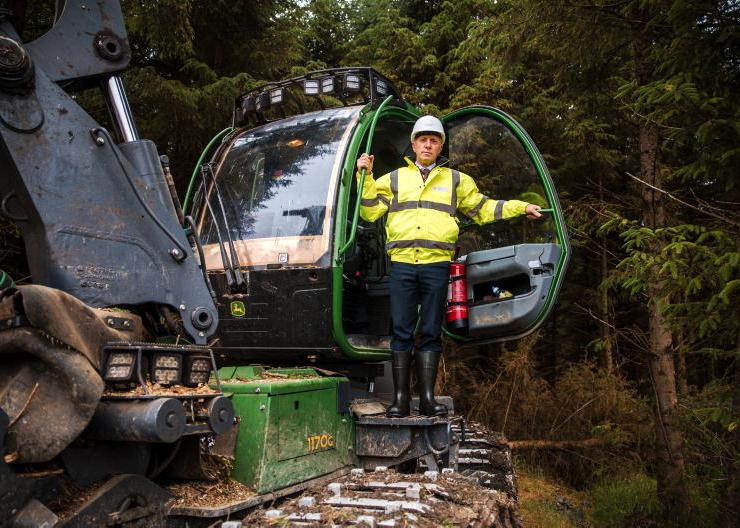Despite the gloomy picture of Irish forestry in recent years, the Irish timber processing sector continues to perform well, despite strong competition from Swedish imports. An estimated 75% of all timber and timber products are exported.
Irish sawmills export at least 65% of their products to UK construction, pallet and fencing markets. Over 90% of wood-based panel (WBP) products are exported throughout Europe but mainly to the UK.
This demonstrates that Irish timber processors can compete in a fiercely competitive international market but could we use more homegrown timber in Ireland?
As outlined in recent articles in the Irish Farmers Journal, we import wood chips from as far away as Brazil for Edenderry Power, while we export pulpwood logs and wood chips which could be utilised for energy generation in Ireland.
That we export sawn timber for construction while importing a similar product is part and parcel of trading in an open economy.
There is still a good domestic market for homegrown timber but it should be a major outlet in construction. While the rest of Europe is maximising timber especially in timber frame housing and medium-rise construction, Ireland is not.
Approximately 24% of all homes in Ireland are timber frame compared with 85% in Scotland and higher throughout Europe. However, on a more confident note, 46% of all scheme houses are timber frame. Disappointingly, the high value and high volume timber components in construction are predominantly imported.
Even if Ireland increased timber buildings to European levels, it is likely that imported timber would capture the high value end of this market.
All of the lucrative truss market in timber frame is sourced from imports according to one sawmill spokesperson, while “open web floor panels comprise 80% imports and 20% Irish timber”.
Irish sawmills access wood elements such as external and internal wall components and tiling batten and bracing material for roof structures.
In addition to timber frame housing, an increasing number of medium to high rise buildings in mass – or engineered – timber are being erected throughout Europe. Unlike Ireland, there is a drive to displace fossil-based materials in the building industry, which is the highest emitter of global greenhouse gas (GHG).
“The Irish Government has a massive opportunity to address the current housing crisis and tackle the challenges of the climate emergency by vastly increasing the use of timber in construction, which locks away carbon for decades,” says Des O’Toole, marketing and communications director, Forest Industries Ireland (FII).
“This will require updating the building regulations to allow for prefabricated engineered timber office buildings and apartments similar to those built across Europe,” he adds.
Technical barriers
Most of the technical barriers, fire and safety issues have been worked out in Europe but not in Ireland.
O’Toole points out that international and national targets to achieve net-zero emissions by 2050 are now in place.
“But they will not happen here unless people wake up to the fact that one of the single biggest cures to tackling GHG emissions is simply growing more trees and using this locally produced timber in our built environment,” he maintains.
“The results of the recent study undertaken by Coillte and University of Galway, show potential to reduce net annual CO2 emissions by 3.4m tonnes over the coming years by changing the way we build our homes.”
O’Toole outlines the annual demand for 32,000 new homes per annum – recently updated to 40,000 by the Government – and believes carbon savings of this magnitude are achievable if “timber frame housing is increased to an average of 55% of new homes built over the period 2022 to 2050”.
There are no technical barriers to using Irish timber but there are design challenges, which are now being addressed by the industry
He believes, the market faces two challenges: to build more timber-based buildings; and to ensure that more homegrown timber is used in both timber frame and medium-rise apartments and office buildings. He is working with the Irish Timber Frame Manufacturers Association (ITFMA), Coillte and the Irish sawmillers in gaining acceptance for Irish timber.
“There are no technical barriers to using Irish timber but there are design challenges, which are now being addressed by the industry, including ITFMA and timber processors,” he says.
Regarding apartment construction in timber, a cross department working group is being established to examine issues such as fire. This will involve the industry, OPW, the Department of Agriculture, Food and the Marine and the Department of Housing, Planning and Local Government.
It is a long overdue initiative and given the urgency of the housing crisis, it should have a timeframe for completion.
Otherwise, it will drift as Project Woodland has being doing for more than two years.
Dashboard
licence
performance
Last week’s forestry licensing dashboard made for pessimistic reading for afforestation and forest roading. Those working in harvesting and timber processing on the other hand will be encouraged by the performance of felling licences.
After 19 weeks, 13,482ha of forests received felling licences, an average of 719ha per week down on 885ha last year but up on the 631ha approved in 2021.
An average of 17ha of afforestation licences were granted each week but the accompanying note provides a more positive note. It states that 272 afforestation applications representing 1,632ha have been approved under the interim de minimis scheme.
It seems that approximately 400ha of this will not be activated as the total State income exceed the minimis fund cap of €200,000 over three years. This balance will be planted as soon as the programme receives State Aid approval.
Forestry companies and nursery spokespeople believe that the afforestation programme will be around 2,000ha at best by year end.
Only 18km of roads were approved or less than 1km per week compared with 5.6km in 2022. However, the Department is confident that total road construction will reach 33.8km before the end of the month.
The ash RUS saw 15 applications approved amounting to 69ha.
Despite the gloomy picture of Irish forestry in recent years, the Irish timber processing sector continues to perform well, despite strong competition from Swedish imports. An estimated 75% of all timber and timber products are exported.
Irish sawmills export at least 65% of their products to UK construction, pallet and fencing markets. Over 90% of wood-based panel (WBP) products are exported throughout Europe but mainly to the UK.
This demonstrates that Irish timber processors can compete in a fiercely competitive international market but could we use more homegrown timber in Ireland?
As outlined in recent articles in the Irish Farmers Journal, we import wood chips from as far away as Brazil for Edenderry Power, while we export pulpwood logs and wood chips which could be utilised for energy generation in Ireland.
That we export sawn timber for construction while importing a similar product is part and parcel of trading in an open economy.
There is still a good domestic market for homegrown timber but it should be a major outlet in construction. While the rest of Europe is maximising timber especially in timber frame housing and medium-rise construction, Ireland is not.
Approximately 24% of all homes in Ireland are timber frame compared with 85% in Scotland and higher throughout Europe. However, on a more confident note, 46% of all scheme houses are timber frame. Disappointingly, the high value and high volume timber components in construction are predominantly imported.
Even if Ireland increased timber buildings to European levels, it is likely that imported timber would capture the high value end of this market.
All of the lucrative truss market in timber frame is sourced from imports according to one sawmill spokesperson, while “open web floor panels comprise 80% imports and 20% Irish timber”.
Irish sawmills access wood elements such as external and internal wall components and tiling batten and bracing material for roof structures.
In addition to timber frame housing, an increasing number of medium to high rise buildings in mass – or engineered – timber are being erected throughout Europe. Unlike Ireland, there is a drive to displace fossil-based materials in the building industry, which is the highest emitter of global greenhouse gas (GHG).
“The Irish Government has a massive opportunity to address the current housing crisis and tackle the challenges of the climate emergency by vastly increasing the use of timber in construction, which locks away carbon for decades,” says Des O’Toole, marketing and communications director, Forest Industries Ireland (FII).
“This will require updating the building regulations to allow for prefabricated engineered timber office buildings and apartments similar to those built across Europe,” he adds.
Technical barriers
Most of the technical barriers, fire and safety issues have been worked out in Europe but not in Ireland.
O’Toole points out that international and national targets to achieve net-zero emissions by 2050 are now in place.
“But they will not happen here unless people wake up to the fact that one of the single biggest cures to tackling GHG emissions is simply growing more trees and using this locally produced timber in our built environment,” he maintains.
“The results of the recent study undertaken by Coillte and University of Galway, show potential to reduce net annual CO2 emissions by 3.4m tonnes over the coming years by changing the way we build our homes.”
O’Toole outlines the annual demand for 32,000 new homes per annum – recently updated to 40,000 by the Government – and believes carbon savings of this magnitude are achievable if “timber frame housing is increased to an average of 55% of new homes built over the period 2022 to 2050”.
There are no technical barriers to using Irish timber but there are design challenges, which are now being addressed by the industry
He believes, the market faces two challenges: to build more timber-based buildings; and to ensure that more homegrown timber is used in both timber frame and medium-rise apartments and office buildings. He is working with the Irish Timber Frame Manufacturers Association (ITFMA), Coillte and the Irish sawmillers in gaining acceptance for Irish timber.
“There are no technical barriers to using Irish timber but there are design challenges, which are now being addressed by the industry, including ITFMA and timber processors,” he says.
Regarding apartment construction in timber, a cross department working group is being established to examine issues such as fire. This will involve the industry, OPW, the Department of Agriculture, Food and the Marine and the Department of Housing, Planning and Local Government.
It is a long overdue initiative and given the urgency of the housing crisis, it should have a timeframe for completion.
Otherwise, it will drift as Project Woodland has being doing for more than two years.
Dashboard
licence
performance
Last week’s forestry licensing dashboard made for pessimistic reading for afforestation and forest roading. Those working in harvesting and timber processing on the other hand will be encouraged by the performance of felling licences.
After 19 weeks, 13,482ha of forests received felling licences, an average of 719ha per week down on 885ha last year but up on the 631ha approved in 2021.
An average of 17ha of afforestation licences were granted each week but the accompanying note provides a more positive note. It states that 272 afforestation applications representing 1,632ha have been approved under the interim de minimis scheme.
It seems that approximately 400ha of this will not be activated as the total State income exceed the minimis fund cap of €200,000 over three years. This balance will be planted as soon as the programme receives State Aid approval.
Forestry companies and nursery spokespeople believe that the afforestation programme will be around 2,000ha at best by year end.
Only 18km of roads were approved or less than 1km per week compared with 5.6km in 2022. However, the Department is confident that total road construction will reach 33.8km before the end of the month.
The ash RUS saw 15 applications approved amounting to 69ha.









SHARING OPTIONS